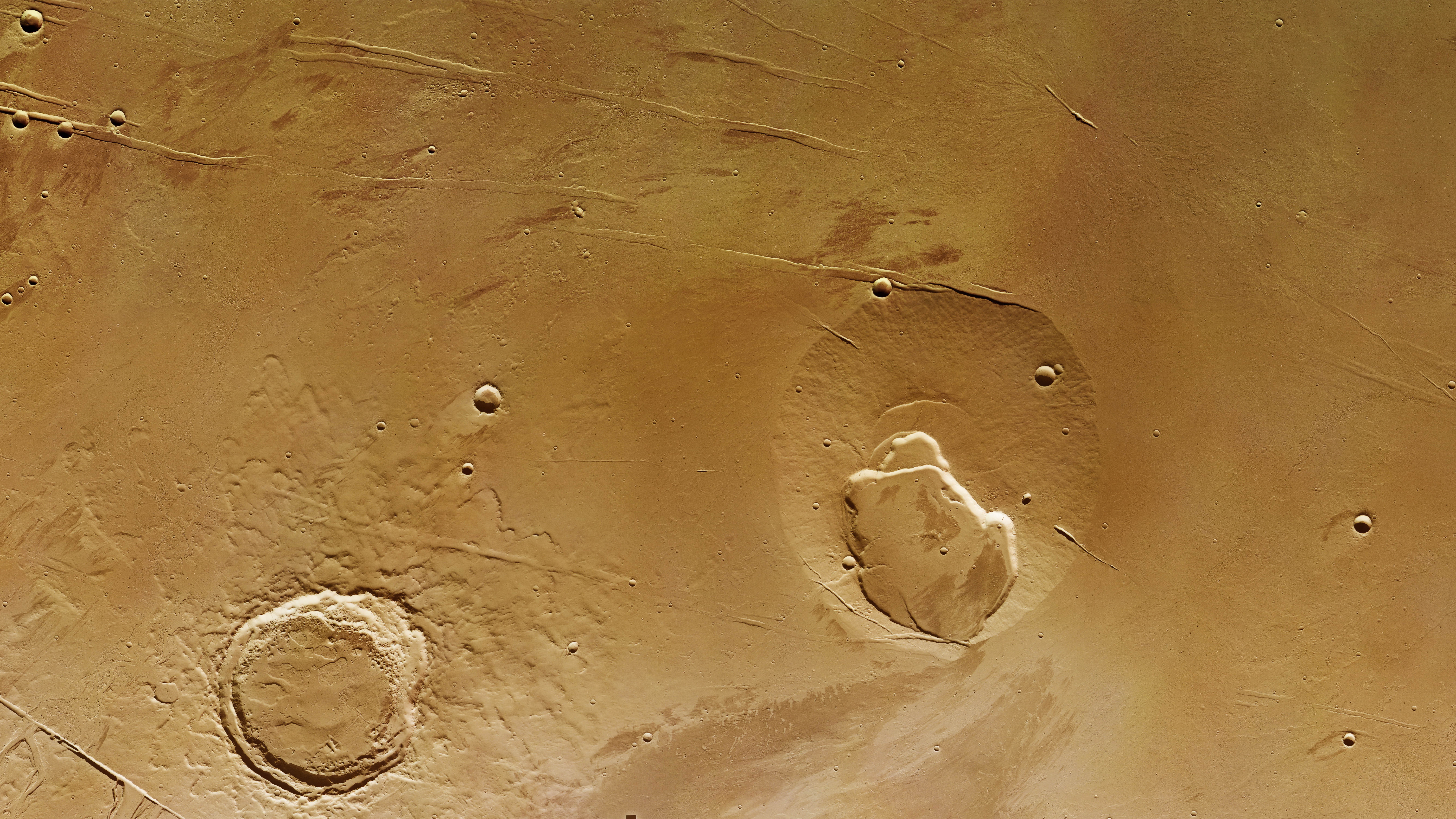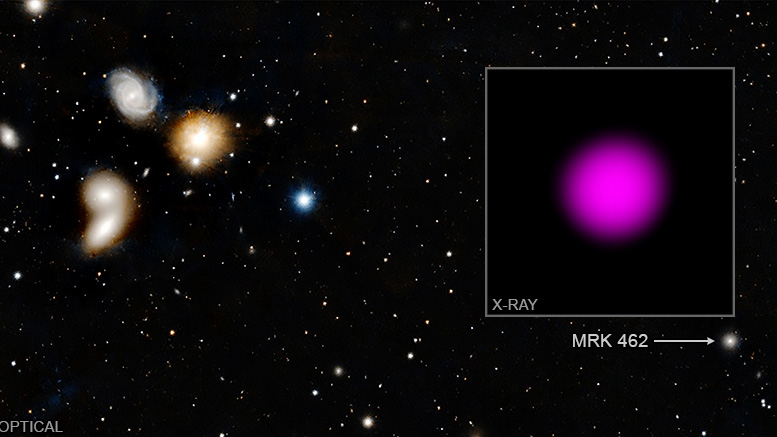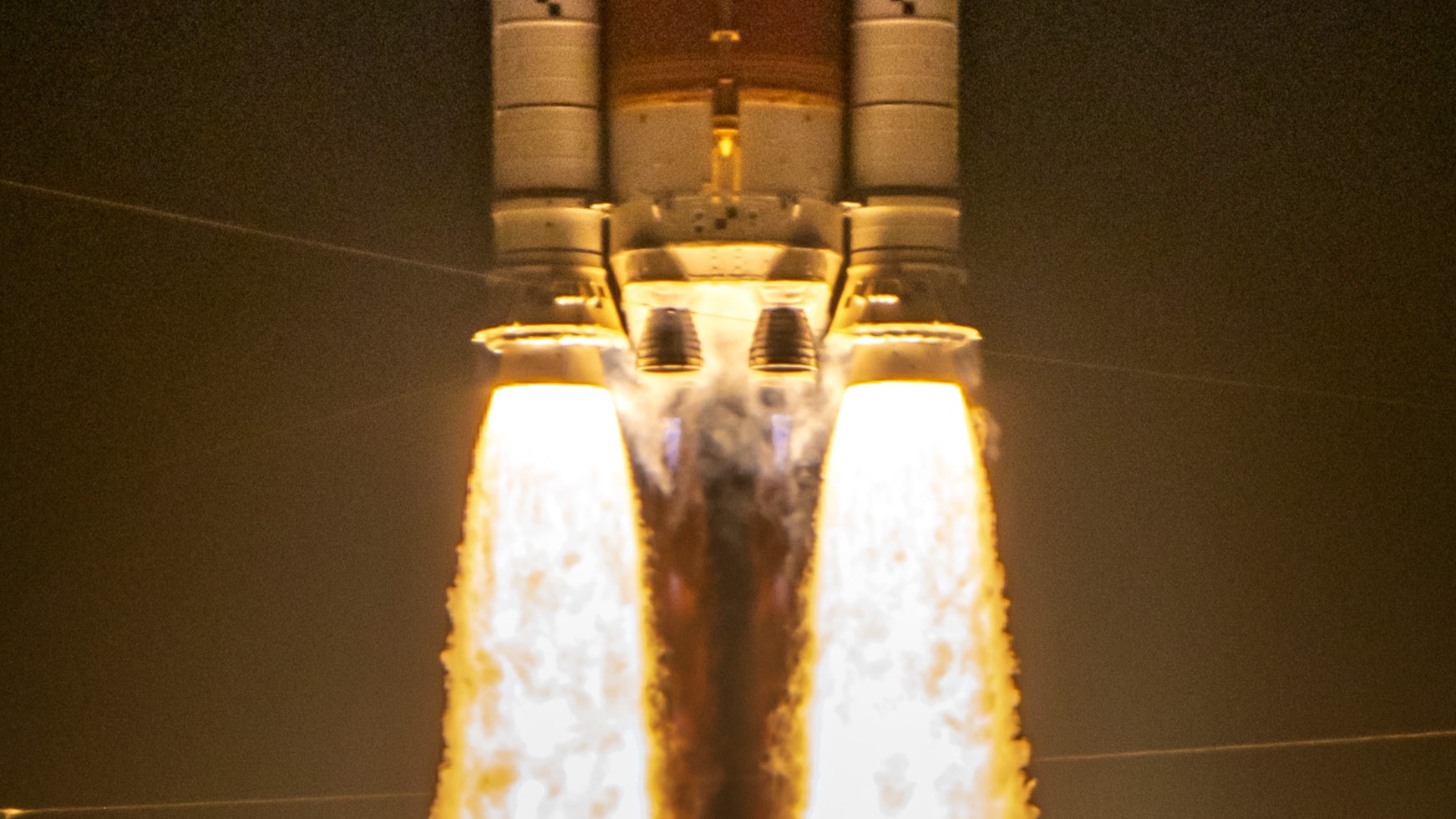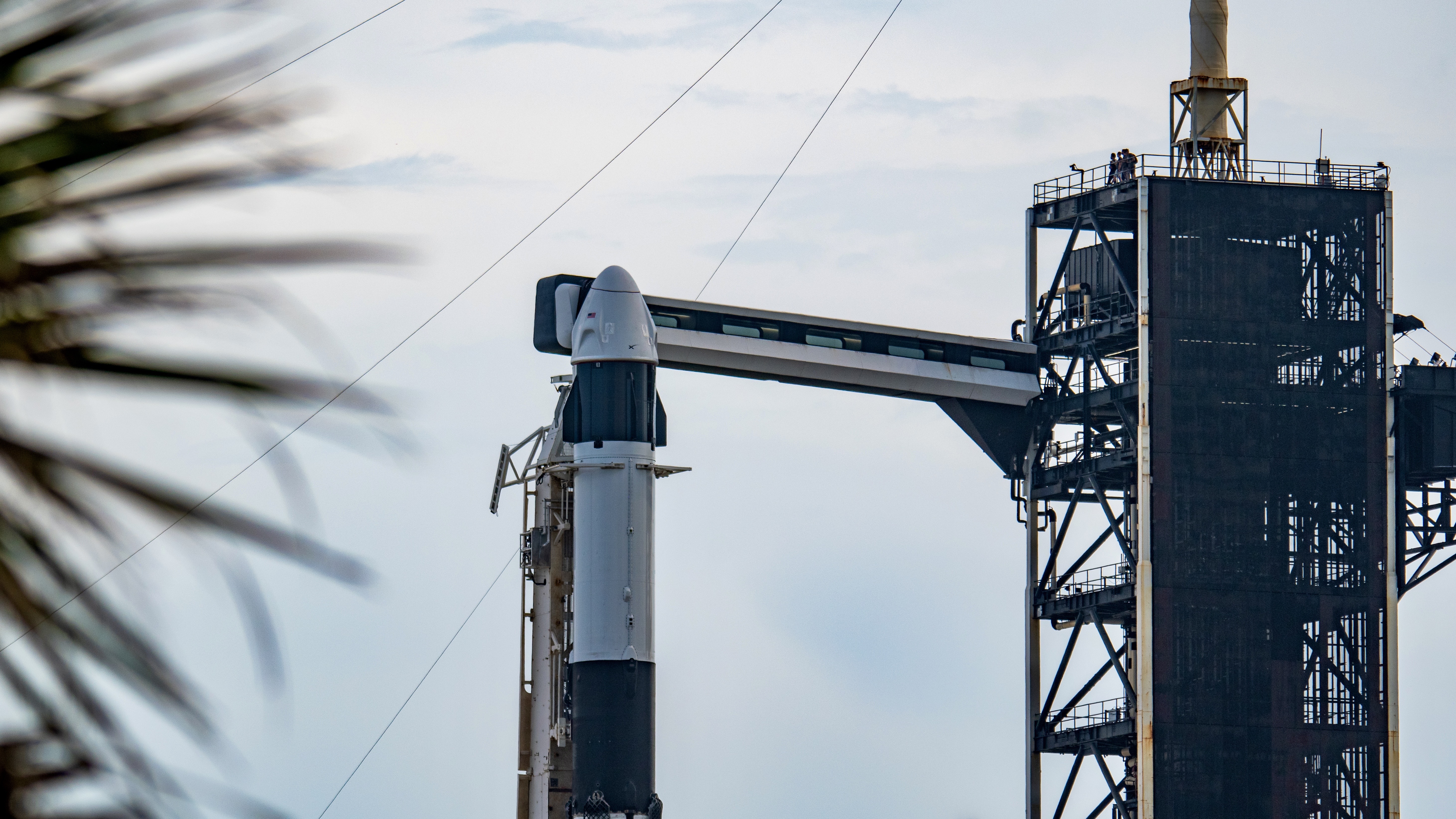Take a trip through time and space to explore all Space.com's Image of the Day photos from 2021!
January 2022
World's largest optical telescope taking shape

Monday, January 31, 2022: The Extremely Large Telescope is currently being built in Chile to enable astronomers to peer deeper into the universe than ever before.
This recently taken image shows the current stage of construction of the 128-feet (39 meters) in diameter telescope that will study the universe from the top of the Cerro Armazones mountain in Chile's Atacama Desert.
Once finished, the Extremely Large Telescope will be the largest optical telescope in the world. The telescope, built by the European Southern Observatory, will be able to see the oldest galaxies in the universe but also study planets orbiting nearby stars. The telescope is currently expected to start operations in 2025. – Tereza Pultarova
Hubble snaps interacting galactic trio

Friday, January 28, 2022: A group of interacting galaxies can be seen in the Hubble Space Telescope image released by NASA on Friday (Jan. 28).
The two galaxies in the upper right corner appear as if they have just smashed into one another with their matter intensely interacting. A third galaxy, below the pair to the left, seems unaffected by the two, featuring a clear set of spiral arms in a regular shape.
The galactic group, referred to as NGC 7764A, lies 425 million light-years away from Earth in the constellation Phoenix.
The two merging galaxies haven't, indeed, just clashed. They have been in a process of colliding for hundreds of millions of years.
Get the Space.com Newsletter
Breaking space news, the latest updates on rocket launches, skywatching events and more!
The image consists of data from two of Hubble's instruments: the Advanced Camera for Surveys and the Wide Field Camera 3. – Tereza Pultarova
European orbiter captures volcanic landscapes on Mars

Thursday, January 27, 2022: The European ExoMars orbiter captured this image of the Jovis Tholus volcano on Mars, revealing abundant traces of past activity.
Jovis Tholus is a so-called shield volcano, a gradually rising volcanic mound resembling a lying warrior's shield. It lies in the shadow of the imposing Olympus Mons, the highest volcano in the solar system.
In this composite picture comprising images gathered by the orbiter's High Resolution Stereo Camera in May and June last year, scientists could distinguish several craters, the largest of which is 17 miles (28 kilometers) wide. In the southwest, flows of lava can be seen flanking what the scientists describe as the youngest of the craters.
The image was released by the European Space Agency on Wednesday (Jan. 26) – Tereza Pultarova
Radio observatory peers into Milky Way's heart

Wednesday, January 26, 2022: The MeerKat telescope in South Africa has captured this image of the center of our galaxy, the Milky Way, revealing never before seen features including outbursting stars and stellar nurseries.
The South African Radio Astronomy Observatory (SARAO) released the image on Wednesday (Jan.26), as part of a study published in the Astrophysical Journal.
The MeerKAT radio telescope, consisting of 64 dish antennas scattered across dozens of miles of South African desert, detects radio signals emitted by distant galaxies, stars and some planets. These signals penetrate dust that obscures the view of optical telescopes, allowing astronomers to peer inside some of the hidden but most fascinating parts of the surrounding universe.
The new images reveal the region around the black hole at the heart of our galaxy, the Milky Way, with shells of material after explosions of massive stars at the end of their lives and a mysterious population of 'radio filaments' that hasn't been seen anywhere else. – Tereza Pultarova
Sun-observing spacecraft flies through tail of comet Leonard
Tuesday, January 25, 2022: A European spacecraft on a mission to take the closest ever images of the sun has flown through the tail of the comet Leonard, collecting a wealth of data about its chemical composition and magnetic field.
The spacecraft, called Solar Orbiter, passed through the comet's tail on Dec. 17, 2021, the European Space Agency (ESA), which operates the spacecraft, said in a statement.
The data, which is still being analyzed, will reveal how the comet interacts with the solar wind, the constant stream of charged particles emanating from the sun.
The interaction took place when Solar Orbiter was relatively close to Earth; about three weeks after it had performed a flyby at our planet at a distance of only 285 miles (460 kilometers).
Although the comet's nucleus was 27.7 miles (44.5 million km) away from Solar Orbiter, close to the planet Venus, its giant tail stretched all the way to Earth's orbit and beyond, ESA said. – Tereza Pultarova
Dragon departs space station after weather delay

Monday, January 24, 2022: European astronaut Matthias Maurer captured this image of the departing Dragon Cargo capsule from aboard the International Space Station on Sunday (Jan. 23).
The spacecraft's departure was delayed by two days due to bad weather in Florida. The spaceship will splashdown on Monday (24. Jan) carrying more than 2 tons of equipment and scientific experiments. – Tereza Pultarova
Sunrise over Rocky Mountains seen from space

Friday, January 21, 2022: European astronaut Matthias Maurer captured this image of the Rocky Mountains between Idaho and Montana in the U.S. bathed in the early morning sunshine.
The European Space Agency shared the image on Twitter on Friday (Jan. 21). Maurer is a member of the SpaceX Crew-3 mission, which arrived at the International Space Station on November 10, 2021.
NASA's Moon rocket readies for roll-out

Thursday, January 20, 2022: NASA's Space Launch System rocket that will test technologies for an upcoming manned trip to the moon is being prepared for its launch pad roll-out.
NASA said in a tweet the rocket, that will fly to the moon as part of the Artemis I mission, will leave the Vehicle Assembly Building at the agency's Kennedy Space Center in Florida next month.
The launch, which will pave the way for humanity's return to the moon after more than five decades, is curently scheduled to take place on March 12 this year. – Tereza Pultarova
NASA astronauts snaps space walking colleagues

Wednesday, January 19, 2022: NASA astronaut Mark Vande Hei took this picture of his Russian colleagues Anton Shkaplerov and Pyotr Dubrov as they commenced planned work on the new Russian Prichal module during a six-hour spacewalk on Wednesday (Jan. 19).
"Russian EVA is in progress as I’m typing this," Vande Hei said in a tweet accompanied by two images. "Super proud to be able to help Petr and Anton get suited up this morning!"
The Prichal module arrived at the International Space Station on Nov. 26 last year. Prichal was Russia's second addition to the orbital outpost in six months. The arrival of Prichal was fortunately uneventful, unlike that of its predecessor Nauka, which limped to the space station in late July with major technical issues and even caused an unintended rotation of the space station after an accidental firing of its thrusters. – Tereza Pultarova
Satellites bear witness to volcanic destruction in Polynesia

Tuesday, January 18, 2022: Destruction on one of the Polynesian islands near the Hunga-Tonga volcano, which erupted on Saturday (Jan. 15), can be seen in this before and after image captured by the European Sentinel-2 Earth observation satellite.
Satellites still provide the main monitoring tool as the entire archipelago remains isolated. The eruption severed a main subsea cable that connects the islanders to the rest of the world. Arrival of humanitarian aid and disaster mitigation teams is complicated by the presence of volcanic ash in the atmosphere, which is potentially hazardous for aircraft.
It is believed that especially some of the smaller, outlying islands have been severely damaged by the tsunami triggered by the eruption.
This particular image shows the impact on the island of Nomuka, about 50 miles northeast of Hunga-Tonga. – Tereza Pultarova
Weather satellites observe apocalyptic Tonga eruption from three angles

Monday, January 17, 2022: Three weather satellites captured the massive underwater volcanic eruption that tore apart the Hunga Tonga-Hunga Ha'apai island in the South Pacific Ocean on Saturday (Jan. 15), revealing the sheer force of the blast from different angles.
The uninhabited island 40 miles (65 kilometers) north of Tongatapu, the main island of the Polynesian Kingdom of Tonga, only existed since 2009 and was fortunately uninhabited. It was born out of another volcanic eruption that merged two smaller islands called Hunga Tonga and Hunga Ha'apai. The remnants of these two islands are now again separated by the ocean.
University of Auckland volcanologist Shane Cronin told Radio New Zealand (RNZ) on Monday (Jan. 17) that the eruption, revealed as a massive explosion in imagery captured by satellites from the altitude of 22,000 miles (36,000 km), may have been the most powerful volcanic eruption on Earth in three decades.
The videos compiled in this GIF were provided by Oxford University research fellow Simon Proud. The collage shows the eruption as seen by the Korean GK-2A satellite (on the left), Japan's Himawari-8 (center) and the U.S. GOES-17 satellite (right), which is operated by NASA and the National Oceanic and Atmospheric Administration (NOAA).
Fleets of low-Earth orbit satellites are now assessing the damage, which Cronin estimated to RNZ to be "apocalyptic" in scale. Scientists, however, think that although the sulfur dioxide from the volcano has already spread over Australia, the eruption is unlikely to have a lasting effect on Earth's climate.
Powerful volcanic eruptions that inject vast amounts of ash particles into the stratosphere, the layer of the atmosphere above the altitude of 12 miles (20 km), can sometimes temporarily cool down Earth as these particles reflect sunlight away from the planet. The effect was observed, for example, after the 1991 eruption of the Mount Pinatubo volcano in the Philippines. That eruption produced a temperature drop that was measurable for three years. – Tereza Pultarova
Satellite images SpaceX nailing booster landing for tenth time

Friday: January 14, 2021: A satellite of U.S. Earth-observation company Planet took this video capturing the landed first-stage booster of a SpaceX Falcon 9 rocket that lifted 105 small satellites into low Earth orbit on Jan. 13.
Planet was among the customers on the flight, SpaceX's third dedicated to its new Transporter ride-sharing program. The 44 SuperDove Earth-observing cubesats on board will strengthen the company's 240-strong fleet that can capture an image of every point of Earth multiple times a day.
It was already the tenth flight for the reusable booster that can be seen in this video sitting comfortably on the landing pad, proving that SpaceX has reliably mastered the ground-breaking rocket landing technology. – Tereza Pultarova
Filter wheel will help James Webb Space Telescope see all shades of the universe

Thursday: January 13, 2021: The filter wheel on the James Webb Space Telescope's instrument MIRI will reveal the universe at 18 different wavelengths.
The filter wheel on the Mid-infrared Instrument (MIRI) was built by scientists at the Max Planck Institute for Astronomy in Germany. Its shape reflects that of James Webb Space Telescope's main mirror. The light gathered by the main mirror will, reach the instrument concentrated after it bounces off the secondary and tertiary mirrors.
MIRI is a combined camera and spectrograph, an instrument that instead of capturing a wholesome image, separates the individual wavelengths that reveal information about the chemical composition of the imaged universe.
The camera will be able to spot the most distant galaxies, detect newly formed stars and find faint comets at the edges of the solar system. – Tereza Pultarova
NASA's new batch of astronauts reports for duty

Wednesday: January 12, 2021: NASA's future astronauts officially started their two-year training earlier this week with an official swearing-in ceremony at the Johnson Space Center in Houston, Texas.
The group of ten astronaut candidates was announced in December, 2021, after a year and a half long selection process that kicked off in March 2020. The new astronauts, six men and four women, will be among the lucky humans that have a good chance to visit the moon as part of the upcoming Artemis missions.
The group includes Nichole Ayers, Marcos Berríos, Christina Birch, Deniz Burnham, Luke Delaney, Andre Douglas, Jack Hathaway, Anil Menon, Christopher Williams and Jessica Wittner. – Tereza Pultarova
Tiny galaxy hides a 'baby' supermassive black hole

Tuesday: January 11, 2021: NASA's X-ray observatory Chandra spotted a supermassive blackhole hiding inside a dwarf galaxy.
The black hole inside the galaxy Mrk 462 is one of the smallest known supermassive black holes, the researchers said, weighing 'only' 200,000 times as much as our sun.
In comparison, Sagittarius A*, the black hole at the center of our own galaxy, the Milky Way, weighs more than 4 million suns.
The black hole's home, Mrk 462, is itself tiny, with only several hundred million stars compared to the Milky Way's few hundred billion.
Black holes in such small galaxies are usually difficult to detect. Astronomers were able to spot this one by looking at the X-ray glow emanating from within the galaxy, a sign of a black hole devouring matter. – Tereza Pultarova
Moon rover tests its wheels in high-tech sandbox

Friday: January 7, 2021: A rover that will fly to the moon with NASA's 2023 Artemis II mission has been put to test to make sure its wheels won't get stuck in the "fluffy" lunar soil.
Although NASA has plenty of experience in driving rovers on Mars, the moon, with considerably lower gravity, is a different beast.
Engineers building the Volatiles Investigating Polar Exploration Rover (VIPER) therefore partnered with Pittsburgh-based ProtoInnovations, to run a series of tests simulating as closely as possible what the rover will experience on the moon.
They tested the rover's wheels in a high-tech sandpit fitted with cameras and sensors to monitor the wheels' behaviour in detail.
The slopes, the size and distribution of the rocks in the sandpit, as well as the texture of the soil, were chosen to mimic what the rover is expected to encounter at its landing site on the lunar South Pole.
"Lunar regolith is fluffy due to the low gravity and lack of most weathering processes, and the particles are sharp like broken glass," Arno Rogg, a rover mobility system engineer at NASA’s Ames Research Center in California’s Silicon Valley said in a statement. "Rocks of various sizes are scattered everywhere on the moon’s surface. All that presented some real engineering challenges to designing a lightweight, performant, and robust wheel for the half-ton rover."
Every slip of the wheel on the simulated lunar surface was analysed to make sure that once on the moon, the rover won't get stuck. The testing was done ahead of the project's Critical Design Review, a key milestone that allows the engineers to finetune the flight model. -- Tereza Pultarova
Europe's next-gen heavy-lift rocket heading for tests

Thursday: January 6, 2021: The core and upper stages of Europe's next-generation heavy-lift rocket Ariane 6 are on the way to the European spaceport in Kourou, French Guiana, for a round of tests ahead of the rocket's delayed maiden flight, which is currently expected in late 2022.
In Kourou, the two stages will for the first time be tested together on a launch pad. The test will involve the first hot-firing of the new Vulcain 2.1 engine, an iteration of Ariane 5's Vulcain 2.
In development since the early 2010s, Ariane 6 will replace the reliable Ariane 5, which on Dec 25. 2021 launched the James Webb Space Telescope, the most expensive and complex space observatory ever built.
The new rocket will be able to launch payloads of up to 11.5 metric tonnes to geosynchronous orbit and up to 21.5 tonnes into low Earth orbit. For comparison, the James Webb Space Telescope, the largest payload ever carried by Ariane 5 weighs 6.2 metric tonnes. The heaviest payload Ariane 5 has ever launched weighed 10.2 metric tonnes and consisted of two telecommunication satellites. -- Tereza Pultarova
James Webb Space Telescope sunshield layers pulled tight

Wednesday: January 5, 2021: The James Webb Space Telescope finished the most challenging part of its post-launch deployment sequence in half the expected time with all five layers of its tennis-court-sized sunshield now pulled perfectly tight.
The proper tensioning of the sunshield was a prerequisite for the telescope's science operations. Anything but perfect execution would prevent the sunshield from correctly performing its task: reflecting heat from the sun and Earth so well that it cools the mirrors and instruments down to minus 400 degrees Fahrenheit (minus 235 degrees Celsius). It is only at this near-absolute-zero temperature that the telescope can make the observations it was designed for.
The challenging manoeuvre relied on an assembly of dozens of cables and motors, all operating in the extreme cold of space, in vacuum and weightlessness. Relief was palpable when NASA operators announced that the tensioning was complete during a live webcast on Tuesday (Jan. 4).
As the grand telescope carries no cameras (they would probably fall apart in the extreme cold of minus 400 degrees Fahrenheit (minus 235 degrees Celsius)), the operators couldn't observe as Webb executed their commands. This animation shows the separation of the five hair-thin space blanket layers of the sunshield into their proper configuration. – Tereza Pultarova
Satellites reveal how volcanic eruption changed the La Palma island

Tuesday: January 4, 2021: The volcanic eruption on the island of La Palma, off the north-western coast of Africa, ended on Dec. 25 after three months of spewing streams of lava. This is how it changed the face of the island.
The 3D visualisation, based on images acquired by the European satellite Sentinel 2 on Monday (Jan. 3), shows the altered landscape on the island's west coast where nearly 3,000 buildings have been buried by the scorching lava rivers since September. The town of Todoque was completely destroyed and so was a large swath of a popular beach.
The European Copernicus program, which operates the Sentinel satellites, said the lava submerged 4.8 square miles (1,241 hectares) of land, the equivalent of about 1,500 football fields, and destroyed 57 miles (92 kilometers) of road infrastructure. – Tereza Pultarova
Hello from Mars!

Monday, Jan. 3, 2022: China's Tianwen 1 orbiter recently captured this amazing view of itself above Mars during a stunning selfie session at the Red Planet.
This photo and several others were captured by a tiny deployable camera that Tianwen 1 deployed in orbit above Mars to photograph itself. This view is a close-up of the Tianwen 1 orbiter, with its solar arrays, gold body and silver antennas clearly visible in the frame. Meanwhile, the north pole of Mars can be seen in the background as the orbiter sails overhead.
You can see more photos from Tianwen 1's selfie session at Mars in our full story here, which also includes an update on the Zhurong rover as it begins 2022 on the Martian surface. -- Tariq Malik
Can't find the date you're looking for? It may have been a weekend or holiday, when we don't normally update our Image of the Day.
Click 'NEXT PAGE' below for February >
Check out our Image of the Day Archives for more awesome photos.
Image of the Day 2024 Archive

Image of the Day 2023 Archive

Image of the Day 2022 Archive

Image of the Day 2021 Archive

Image of the Day 2020 Archive

Image of the Day 2019 Archive

Join our Space Forums to keep talking space on the latest missions, night sky and more! And if you have a news tip, correction or comment, let us know at: community@space.com.

Space.com is the premier source of space exploration, innovation and astronomy news, chronicling (and celebrating) humanity's ongoing expansion across the final frontier. Originally founded in 1999, Space.com is, and always has been, the passion of writers and editors who are space fans and also trained journalists. Our current news team consists of Editor-in-Chief Tariq Malik; Editor Hanneke Weitering, Senior Space Writer Mike Wall; Senior Writer Meghan Bartels; Senior Writer Chelsea Gohd, Senior Writer Tereza Pultarova and Staff Writer Alexander Cox, focusing on e-commerce. Senior Producer Steve Spaleta oversees our space videos, with Diana Whitcroft as our Social Media Editor.
